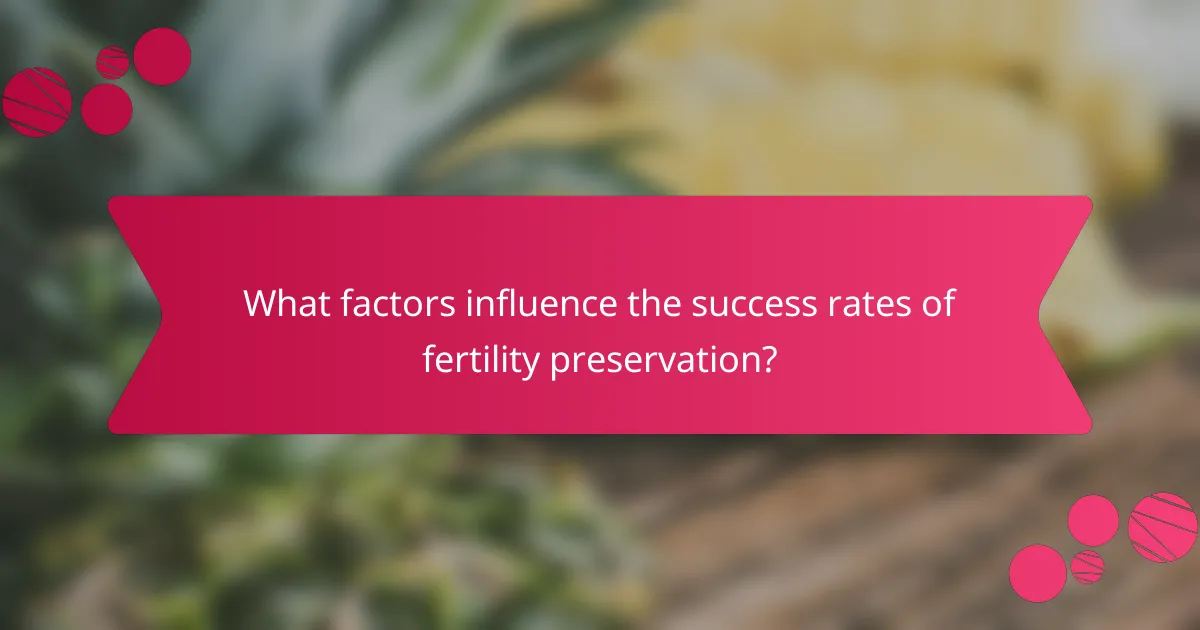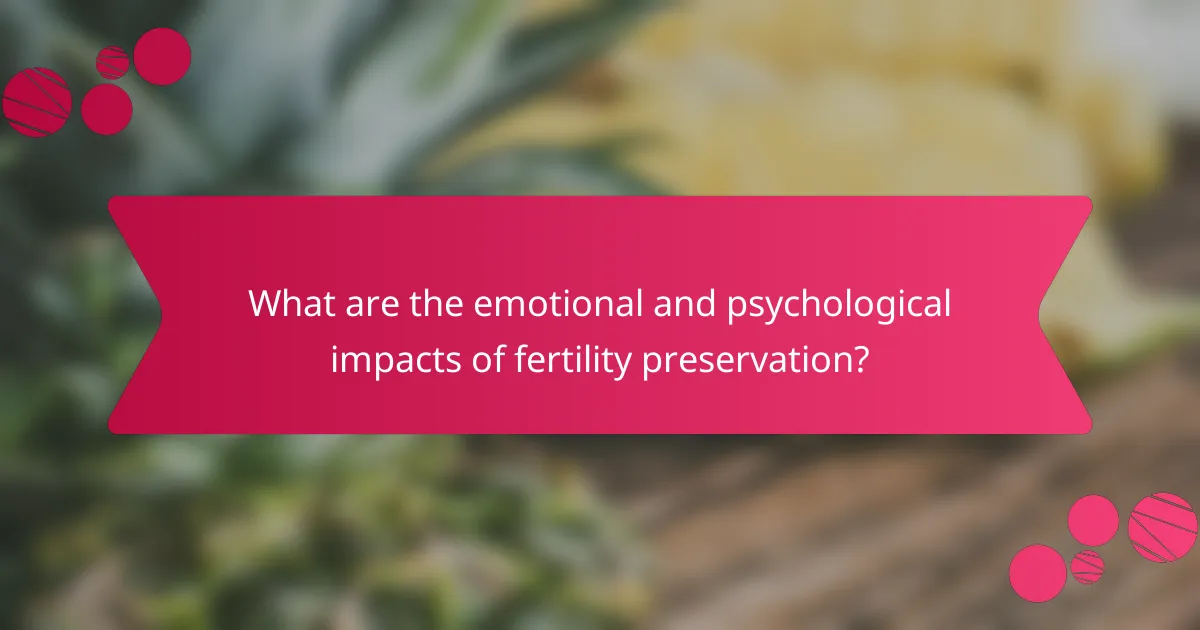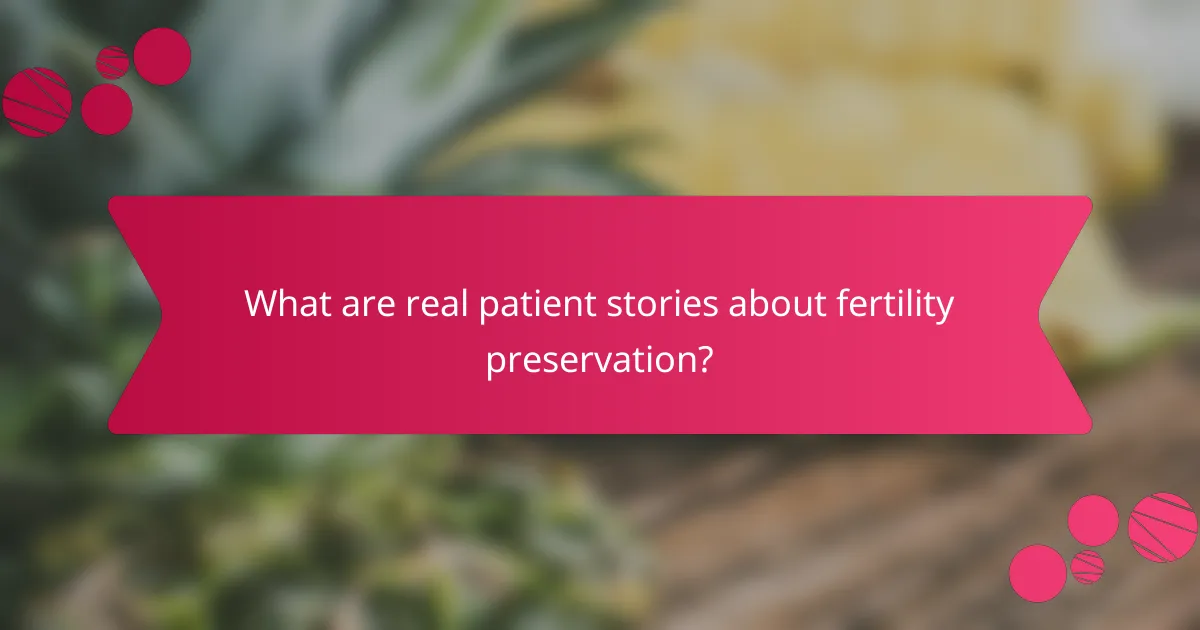Fertility preservation techniques offer hope for individuals facing challenges in starting a family. This article explores common methods like egg freezing, sperm freezing, embryo freezing, and ovarian tissue freezing, detailing their success rates and influencing factors. Patient stories illustrate the emotional journey and resilience associated with these options. Regional differences in access and practices also play a crucial role in decision-making for prospective parents.

What are the most common fertility preservation techniques?
The most common fertility preservation techniques include egg freezing, sperm freezing, embryo freezing, and ovarian tissue freezing. Each method offers unique advantages and varying success rates.
Egg freezing allows women to preserve their eggs for future use, with success rates around 5-10% per thawed egg. Sperm freezing is widely practiced and has high success rates, often exceeding 90% for thawed samples. Embryo freezing combines sperm and eggs, offering a higher success rate of about 30-50% per thawed embryo. Ovarian tissue freezing is a less common option but can be beneficial for women facing immediate fertility threats, such as cancer treatment.
Patient stories highlight the emotional and practical impacts of these techniques, showcasing hope and success in achieving parenthood despite challenges.
How does egg freezing work?
Egg freezing involves extracting eggs from the ovaries, freezing them, and storing them for future use. The process typically includes ovarian stimulation, egg retrieval, and cryopreservation.
Ovarian stimulation uses hormones to encourage the ovaries to produce multiple eggs. This usually takes about 10-14 days. Once mature, a minor surgical procedure retrieves the eggs. After retrieval, the eggs are frozen using a method called vitrification, which prevents ice crystal formation and preserves egg quality.
Success rates for egg freezing vary, influenced by age and egg quality. Younger women generally have higher success rates. Patient stories often highlight emotional and physical experiences during the process, emphasizing the importance of support and information.
What is sperm banking?
Sperm banking is a fertility preservation technique that allows individuals to store sperm for future use. This method is beneficial for those facing medical treatments, like chemotherapy, or for men who wish to delay fatherhood. The success rates of sperm banking depend on factors such as the individual’s age and health, but many success stories highlight its effectiveness in achieving parenthood later in life.
How is embryo freezing performed?
Embryo freezing is performed through a process called cryopreservation. This involves several key steps: first, embryos are created via in vitro fertilization. Next, they are carefully monitored for development. Once they reach the appropriate stage, embryos are treated with a cryoprotectant to prevent ice crystal formation. Finally, they are cooled gradually and stored in liquid nitrogen at -196 degrees Celsius. This method preserves the embryos for future use, with success rates varying based on the age of the patient and the quality of the embryos.
What are the emerging techniques in fertility preservation?
Emerging techniques in fertility preservation include oocyte vitrification, ovarian tissue cryopreservation, and preimplantation genetic testing. These methods offer improved success rates and cater to diverse patient needs. Oocyte vitrification allows for the freezing of eggs without ice crystal formation, enhancing viability. Ovarian tissue cryopreservation offers a unique approach, preserving ovarian function for future use. Preimplantation genetic testing ensures the selection of healthy embryos, reducing genetic disorders. These advancements reflect a growing understanding of reproductive health and patient-centric care.

What factors influence the success rates of fertility preservation?
Several factors influence the success rates of fertility preservation, including age, ovarian reserve, technique used, and underlying health conditions. Age is critical; younger individuals generally have higher success rates. Ovarian reserve tests assess egg quantity and quality, impacting outcomes. Techniques like egg freezing or embryo freezing vary in effectiveness. Lastly, health conditions such as hormonal imbalances can affect fertility preservation success.
How does age affect success rates?
Age significantly influences success rates in fertility preservation techniques. Younger individuals generally experience higher success rates due to better egg quality and quantity. For instance, women under 35 have a 50% success rate with egg freezing, while those over 40 see rates drop to 10%. Additionally, age affects sperm quality, impacting male fertility preservation outcomes. As a result, timing is crucial for optimizing success in these techniques.
What role does health status play in outcomes?
Health status significantly influences fertility preservation outcomes. Factors like age, underlying medical conditions, and lifestyle choices can affect success rates. For instance, younger patients typically have higher success rates with techniques such as egg freezing compared to older patients. Additionally, conditions like cancer can impact both the urgency and effectiveness of preservation methods. Understanding these dynamics helps tailor approaches to individual needs, enhancing overall success in fertility preservation.
Which techniques have the highest success rates?
Fertility preservation techniques with the highest success rates include egg freezing, embryo freezing, and sperm banking. Egg freezing has a success rate of approximately 90% for women under 35. Embryo freezing shows a success rate of around 50% to 60% per transfer. Sperm banking generally achieves a success rate of about 70% to 80% after thawing. These techniques are crucial for individuals seeking to preserve fertility for future family planning.

What are the emotional and psychological impacts of fertility preservation?
Fertility preservation can lead to significant emotional and psychological impacts, including anxiety, hope, and empowerment. Patients often experience stress related to uncertainty about future fertility. However, successful preservation techniques can foster optimism and a sense of control over reproductive choices. Support from healthcare providers and peer networks enhances coping mechanisms, reducing feelings of isolation. Ultimately, the emotional journey varies, but many find strength through the process.
How do patients cope with the decision to preserve fertility?
Patients cope with fertility preservation decisions through informed discussions, emotional support, and personal reflection. Many seek guidance from healthcare professionals to understand options like egg freezing or sperm banking. Patient stories reveal that connecting with others who faced similar choices can provide comfort. Additionally, mental health resources, such as counseling, help individuals navigate the emotional complexities involved in these decisions.
What support resources are available for patients?
Patients have access to various support resources for fertility preservation. These include counseling services, financial assistance programs, and informational workshops. Many clinics offer psychological support to help patients navigate emotional challenges. Online communities and support groups provide shared experiences and advice. Additionally, educational materials are available to inform patients about their options and success rates.

How do fertility preservation options differ by region?
Fertility preservation options vary significantly by region due to cultural, legal, and medical factors. In North America, egg freezing is widely accepted, with success rates around 30% per cycle. In Europe, regulations may limit access to certain techniques, affecting availability. Asian countries often emphasize traditional practices alongside modern methods, leading to diverse approaches. Access to fertility preservation in Africa remains limited, with lower success rates due to fewer resources. Understanding these regional differences helps patients make informed decisions about their options.
What are the cultural attitudes towards fertility preservation in North America?
Cultural attitudes towards fertility preservation in North America are increasingly positive and supportive. Many view these techniques as essential for family planning and personal autonomy. Societal acceptance has grown, particularly among younger generations who prioritize career and education before starting families.
Awareness campaigns and media representation have contributed to destigmatizing fertility preservation, making options like egg freezing more mainstream. Success rates for these techniques vary, with studies showing that younger women tend to have higher success rates.
Patient stories often highlight the emotional and financial challenges faced during the process, yet many express gratitude for the opportunity to preserve their fertility. Overall, North American culture is evolving to embrace fertility preservation as a viable option for future family planning.
How do European practices compare?
European fertility preservation techniques vary significantly in options and success rates. Countries like Spain and Belgium offer advanced IVF methods with high success rates, often exceeding 50% for women under 35. In contrast, nations like Germany emphasize legal regulations, which can limit access to certain techniques. Patient stories reveal diverse experiences, highlighting the emotional and logistical challenges faced across different healthcare systems. Overall, the landscape reflects a blend of innovative practices and regulatory environments affecting patient choices and outcomes.

What are real patient stories about fertility preservation?
Real patient stories about fertility preservation highlight diverse experiences and outcomes. Many patients share positive results, emphasizing the emotional and physical support received during the process. Techniques such as egg freezing and embryo preservation have shown success rates ranging from 30% to 50%, depending on age and health factors. These narratives often focus on personal journeys, resilience, and the hope of future parenthood.
What challenges did patients face during their journeys?
Patients faced numerous challenges during their fertility preservation journeys, including emotional stress, financial burdens, and medical uncertainties. Many experienced anxiety about the effectiveness of techniques such as egg freezing or sperm banking. The complexity of treatment protocols and the need for multiple appointments added logistical difficulties. Additionally, societal stigma and personal fears about future fertility outcomes further complicated their experiences.
What successes have patients experienced?
Patients have experienced significant successes with fertility preservation techniques, leading to successful pregnancies and family growth. Many have reported positive outcomes after using methods like egg freezing, sperm banking, and embryo preservation. For instance, studies indicate that the success rate of live births from frozen eggs is around 2-12% per cycle, depending on age and health factors. Patient stories highlight emotional resilience and hope, showcasing how these techniques have allowed individuals to pursue parenthood later in life. Each success story emphasizes the importance of personalized treatment plans tailored to unique circumstances.

What best practices should patients follow when considering fertility preservation?
Patients should consult with a fertility specialist to understand their options for fertility preservation. Key best practices include assessing individual health conditions, exploring various techniques like egg freezing or sperm banking, and considering the timing of preservation based on personal circumstances. Additionally, discussing success rates and potential risks associated with each method is crucial. Engaging in patient stories can provide insights and emotional support, helping patients make informed decisions.
How to choose the right fertility preservation technique?
To choose the right fertility preservation technique, consider your medical history, age, and personal goals. Common options include egg freezing, sperm banking, and embryo freezing. Each technique has varying success rates influenced by factors like age and health. Consulting a fertility specialist can provide tailored insights based on individual circumstances.
What questions should patients ask their healthcare providers?
Patients should ask their healthcare providers about fertility preservation techniques, including options, success rates, and personal experiences. Key questions include:
1. What fertility preservation options are available for my situation?
2. What are the success rates for these techniques based on my age and health?
3. Can you share patient stories or testimonials related to these options?
4. What are the potential risks and side effects of each technique?
5. How long can preserved fertility options remain viable?
6. What financial considerations should I be aware of regarding these procedures?
What common mistakes should be avoided?
Avoiding common mistakes in fertility preservation is crucial for success. Key errors include neglecting to consult specialists, overlooking the emotional impact, and failing to understand the financial implications. Patients often underestimate the importance of timing and the variety of available techniques, such as egg freezing or sperm banking. Additionally, not researching success rates can lead to unrealistic expectations. Prioritizing informed decision-making enhances the chances of achieving desired outcomes.
